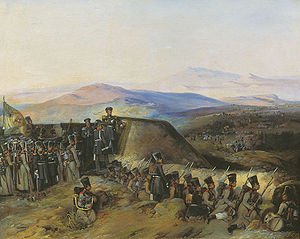|
|||
|
Philatelia.Net / Fragments of Russian History / Plots / The directory «Plots»1828/1829. Russo–Turkish WarThe Russo–Turkish War of 1828–1829 was sparked by the Greek War of Independence. The war broke out after the Sultan, incensed by the Russian participation in the Battle of Navarino, closed the Dardanelles for Russian ships and revoked the Akkerman Convention. When the hostilities erupted, the Russian army consisted of 92,000 men, as opposed to the Ottoman forces of some 150,000, commanded by Hussein Pasha. In June 1828, the main Russian forces, led by Emperor Nicholas I, crossed the Danube and advanced into Dobruja. Prior to that, the Russian commander-in-chief, Prince Peter Wittgenstein, had moved into Wallachia and took Brăila and Bucharest without difficulty. Then the Russians laid prolonged sieges to three key citadels of Bulgaria — Shumla, Varna, and Silistria. Owing to the help of the Black Sea Fleet under Aleksey Greig, Varna was the first to be taken (September 29). The siege of Shumla proved much more problematic, as the 40,000-strong Ottoman garrison outnumbered the Russian forces. Furthermore, the Ottomans succeeded in cutting the Russians from supplies of provisions. The resultant famine and proliferation of diseases claimed more lives than all the hostilities undertaken during the war. As winter approached, the Russian army was constrained to leave Shumla and retreat back to Bessarabia. In February 1829 old Wittgenstein, whose cautiousness bordered on timidity, was replaced by more energetic Hans Karl von Diebitsch, while the tsar left the army for St Petersburg. On May 7 Dibich with 60,000 soldiers crossed the Danube and resumed the siege of Silistria. The Sultan sent a 40,000-strong contingent to the relief of Varna, but the latter was annihilated by Dibich in the Battle of Kulevicha (May 30). Within several weeks, Silistria fell to the Russians (June 19). Simultaneously, Ivan Paskevich, operating on the Caucasian front, took Akhalzic, Erivan, and Kars and, accompanied by the poet Alexander Pushkin, seized Erzerum in north-eastern Anatolia, thus marking the 120th anniversary of the Poltava (June 27). On July 2 Dibich startled the Turks by launching a Transbalkan offensive, the first in the Russian history since the 10th-century campaigns of Svyatoslav I. The contingent of 35,000 Russians moved across the mountains, circumventing the besieged Shumla on their way straight to Istanbul. Burgas fell ten days later, and the Turkish reinforcement was routed near Sliven on July, 31. By August, 28 Dibich advanced within 68 kilometers from Constantinople, causing panic on the streets of the capital. The Sultan had no other choice but to sue for peace, which was concluded in Edirne on September 14, 1829. The Treaty of Adrianople gave Russia most of the eastern shore of the Black Sea and the mouth of the Danube. Turkey recognized Russian sovereignty over Georgia and parts of present-day Armenia. Serbia achieved autonomy and Russia was allowed to occupy Moldavia and Walachia (guaranteeing their prosperity, and full "liberty of trade" for them) until Turkey had paid a large indemnity. The Straits Question was settled four years later, when both powers signed the Treaty of Unkiar Skelessi. Burundi, 2011, Brig Mercury Attacked by Two Turkish Ships Gambia, 2001, Battle of Navarino Greece, 1927/1928, Navarino Bay and Pylos Greece, 1927/1928, Battle of Navarino Greece, 1927/1928, Edward Codrington Greece, 1927/1928, Edward Codrington Greece, 1927/1928, Van der Heyden Greece, 1977, Battle of Navarino Greece, 1977, Admirals Van der Heyden, Codrington and de Rigny Paraguay, 1977, Battle of Varna (C. L. Hoffmeister) Greece, 1977.10.20, Russia, 2010, Ukraine, 1999, Ukraine, 2000, Advertising: |
|||
© 2003-2025 Dmitry Karasyuk. Idea, preparation, drawing up
|

